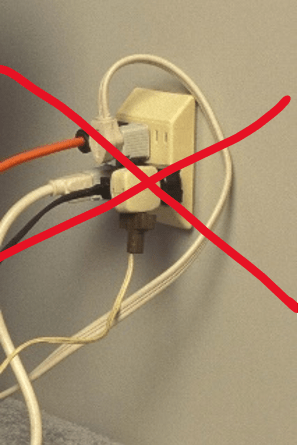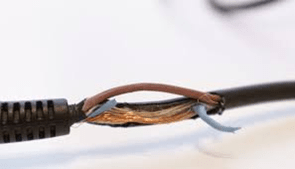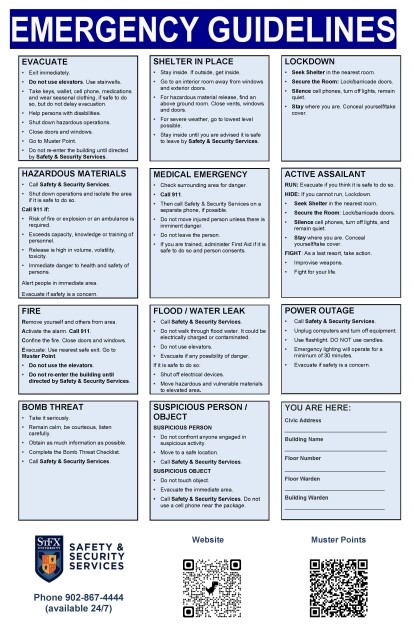
Know the Emergency Evacuation plan for your building.
Become familiar with the Evacuation Map and Safety Wardens in your area. Ensure you know the location of the primary and secondary evacuation routes, pull stations and fire extinguishers. When a building fire alarm system is activated, all faculty, staff and students must evacuate immediately and not remain in the building. Do not re-enter the building until given the all-clear by Safety & Security.
Keep Exit Passageways Clear.
Aisles within rooms, main corridors and stairwells must be kept free and clear of any materials that will block, hinder or slow egress during an emergency. Fire and rescue personnel enter these areas, and any blockage can hinder them. Do not store materials or equipment in corridors or stairwells. Such storage narrows the exit path and is fuel for the fire.

Ensure Fire Doors Stay Closed.
Always keep fire doors closed. The only exception is doors that are held open via automatic hold open devices connected to the building alarm system, which automatically release upon activation of the alarm. Fire doors serve a purpose in the event of a fire. The doors will impede the fire and smoke from spreading and can help eliminate smoke and heat damage to a building. They can be propped open, if necessary and while attended, for a short period to perform a task. When the task is done, the door must be closed. Fire Doors can be identified by the label on the inside of the door or the location of the door.
Keep Sprinkler Heads Clear.
In buildings with sprinkler systems, do not place or store material within 47 cm (18 inches) of sprinkler heads. When sprinklers are activated, a full spray pattern is needed to effectively control the fire.
Maintain Good Housekeeping.
Good housekeeping is essential in all workplaces. Keep materials and items organized and neatly stored. Minimize the number of combustible materials such as books, papers, boxes, etc., to prevent adding to the fuel load.
Keep Extinguishers and Pull Stations Clear.
Never block or store items in front of fire extinguishers, fire alarm pull stations, and fire alarm audiovisual devices. Immediate access is critical in the event of a fire.
Check with Facilities Management before using a Portable Electric Space Heater.
If you find your workplace to be particularly cold, please contact Facilities Management to have the issue assessed. Portable electric space heaters used on campus should be supplied and installed by Facilities Management. Improper use of portable electric heaters can be a serious fire and electrical hazard. Click this link for more portable electric space heater safety tips.
No open flames (except in labs and FM work areas).
Open flames such as candles are not allowed outside of designated work and lab spaces. Candles can easily tip over or start combustible items on fire. A safer option is using flameless candles. There are several types available that look the same as real candles.

Avoid using extension cords.
Use of extension cords should be avoided. Be sure to check the owner’s manual before using them for electrical appliances or equipment to see if their use is permitted by the manufacturer. All electrical cords and plugs must be in good condition. Never use equipment with frayed cords or exposed wires; if discovered, immediately take the equipment out of service and have it repaired or replaced. When you must use extension cords, make sure they are rated for the task at hand. Click here for some extension cord safety tips.
Do not overload outlets.
Some buildings have limited outlets. If you require extra power sources in your workspace, please contact Facilities Management. They will be able to guide you on the best options, depending on your space and equipment being used.

Report exposed wiring.
All electrical wall outlets and overhead light fixtures must be covered and have no exposed wiring. Exposed wiring should be reported to Facilities Management.
Keep electrical panels clear.
Never block electrical panels with equipment or materials. Immediate access to these panels may be needed by maintenance or emergency responders. Always maintain at least a 36-inch unobstructed pathway leading to electrical panels.
Safely Store and Recycle Batteries.
Store batteries safely to reduce the risk of fires or explosions. Loose batteries kept in a desk drawer, for example, are a fire hazard. If metal comes into contact with both the positive and negative posts of a battery, it could cause a short circuit that generates enough heat to start a fire. Keep batteries away from metal, like coins, keys or other batteries. Store them at room temperature, in their original packaging in a well-ventilated, dry, secure place. Recycle your batteries through StFX’s Battery Recycling Program.
Check coffee pot before leaving for the day.
An empty coffee pot left on can quickly overheat and the heat can ignite anything that is nearby, leading to a fire. Ensure someone checks at the end of the day, and unplugs this, and all electrical appliances, when not in use.

Familiarize Yourself with the StFX Emergency Guidelines.
Emergency Guideline Posters are posted in every building. They include a brief overview of what to do in case of emergencies, along with civic address, names of floor and building wardens, and QR codes that link to the Fire and Emergency Webpage and the Muster Points map.
Click this link to the Fire and Emergency Webpage for more information.
Contact
212 Safety & Security Building
5005 Alumni Crescent
Antigonish NS B2G 2W5
Canada

